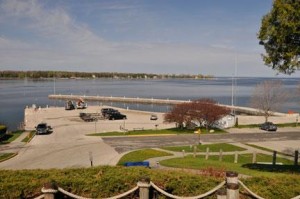Marina Still Breathing
- Share
- Tweet
- Pin
- Share
The Egg Harbor Village Board said it hopes to bring another marina referendum to a vote before the end of July, but after its June 8 meeting it remained unclear what plan it would be offering its citizens.
On May 26, village voters rejected a $6.6 million, 63-slip marina with an 87 – 81 tally against a design created by JJR engineers of Madison. But in a meeting after the vote, many residents who voted no said they still wanted a marina in the village, but would only support a smaller version, even if it cost more. A citizens committee formed to develop an alternative plan unveiled a proposal Tuesday, June 9.
A special meeting of the village board is tentatively scheduled for June 18, when the village will choose a path to go on the marina.
The citizens committee, led by Steve Schaefer and Bob Doneff, worked with Mike Kahr of Death’s Door Marine to come up with the alternative plan, which would essentially split the difference between the size of the present marina and that proposed by the village. It would reduce the number of slips from 66 to 51 (the current marina has 34 – 42 slips, depending on water depth and conditions). It would also reduce the height of the breakwall from +10 IGLD (International Great Lakes Datum, the reference system used to measure Great Lakes water levels) to +6.5 feet. The current breakwall is at +6 feet. The high-water mark is +4.8 feet, but water levels are currently at +1.
Kahr said reducing the breakwall height would allow people to see the horizon line from the shore, which is not the case with JJR’s plan. It would also make fishing off the pier easier. The JJR breakwall would rise about nine feet above the current water level. At Monday’s village board meeting, JJR’s Bill Brose said the breakwall was designed at that height to provide protection in the event of a hundred year storm event at peak Lake Michigan water levels. The record high level was reached in 1986, and at Monday’s meeting, nobody in attendance could recall any problems for boats or pedestrians that year, when water levels were 3.8 feet higher than today.
Brose said lowering the breakwall would not jeopardize grant or permit approvals, but would require that the village sign off on a higher level of risk.
The Kahr plan, though smaller, would actually cost only $600,000 less than the JJR plan because it has fewer revenue-generating slips. The total taxpayer-supported share of the revised plan is estimated at $2.9 million, while the taxpayer-supported share of the JJR plan is $2.635 million.
Kahr also prepared a bare bones estimate to repair the existing marina by wrapping it in steel sheeting and putting a rubble breakwall on the outside for protection. That would cost about $3 million, he said, without upland improvements and aesthetic enhancements, while retaining the current number of slips, producing no new revenue. The taxpayer-supported share of that plan is estimated at $2.617 million, but the village has repeatedly dismissed that plan as unworkable. The JJR plan, though it’s larger and includes a higher capital cost, carries a lower taxpayer-supported share thanks to higher revenue from the increase in slips, plus a $1.185 million grant from the Wisconsin Waterways Commission, which a repair is not eligible for.
Jim Sarkis questioned the economic efficiency of the committee’s 51-slip plan.
“You’re getting a 10 percent reduction in cost for a 21 percent reduction in slips,” he said.
Doneff said the Kahr design attacked scope and scale issues, and conceded that the JJR plan would provide the greatest return on investment for the village.
“Operating a smaller marina is going to be almost the same as operating a larger marina,” he said. “Strictly from a return-on-investment standpoint the larger format makes more sense.”
Schaefer urged the village to increase its slip rates from $110 to $120 per foot to relieve some burden on taxpayers. That would put Egg Harbor rates about 25 percent higher than other public marinas in Door County, but less than the $128 charged at Yachtworks.
Doneff, who owns a boat, suggested the village stop offering discounted slip rates to village residents.
“Why should 99 percent of the citizens subsidize the 1 percent who have slips?” said Doneff.
Jack McCoy pointed out that neither the citizens group nor the village included interest costs in their estimates. Village Administrator Josh Vanlieshout said interest payments for the JJR plan add an additional $3.2 million to the cost. Interest on the revised plan would likely be only slightly less, while interest payments on the Kahr proposal to repair the breakwall would be less than half that amount.
Brose advised the village not to tear down the existing breakwall until it’s certain how the village will proceed on the marina. Leaving it will reduce construction costs for a new breakwall. In the meantime, Brose said the public should be allowed on the breakwall. The board decided to erect a chainlink fence to keep people off it.
Though open to a scaled back plan, Village President Nancy Fisher questioned the wisdom of losing the return on investment of the larger plan.
“If it’s not the marina that takes us 20 – 40 years into the future, it may not be worth the money at all,” Fisher said.
Check http://www.ppulse.com for further Egg Harbor Marina updates.




